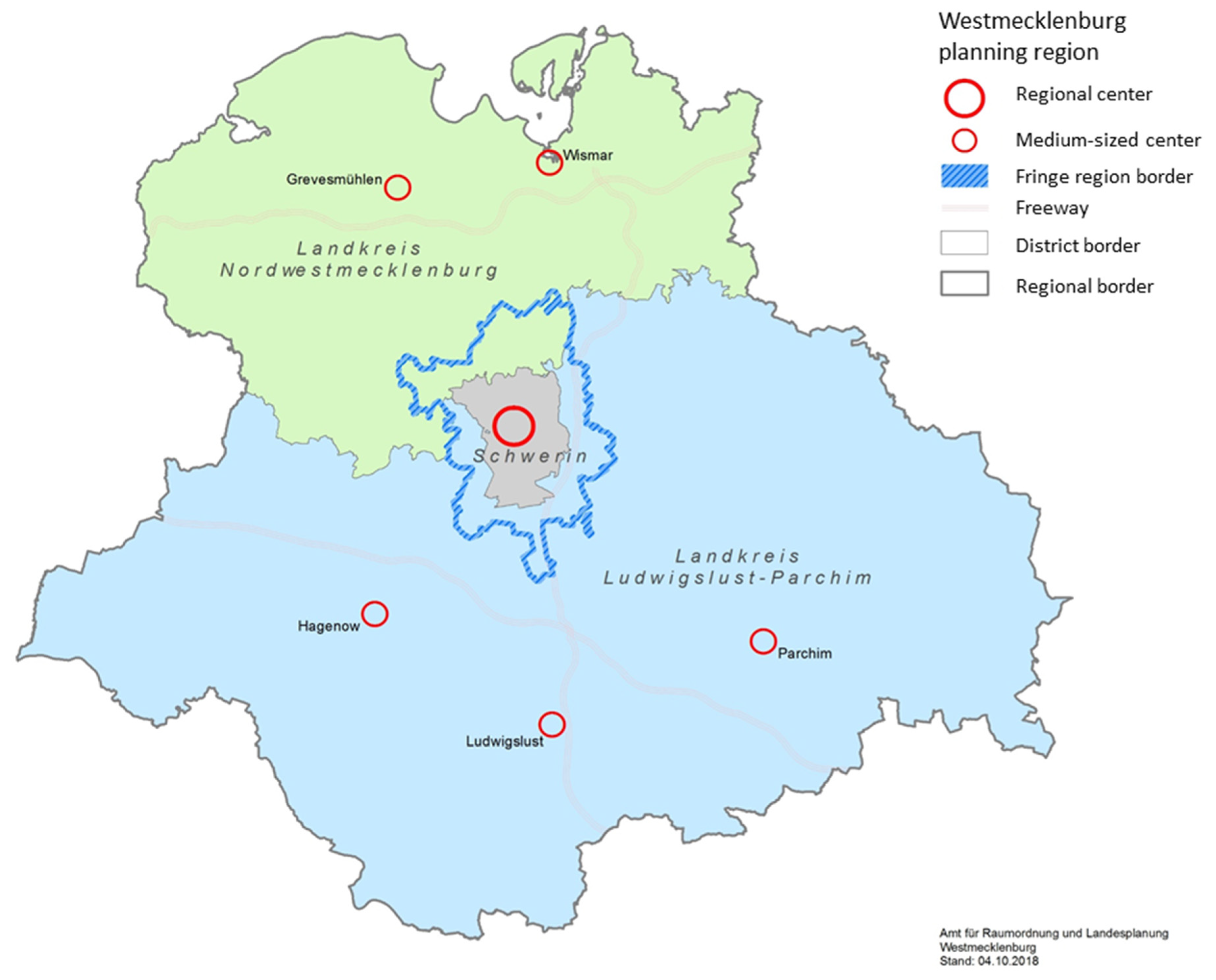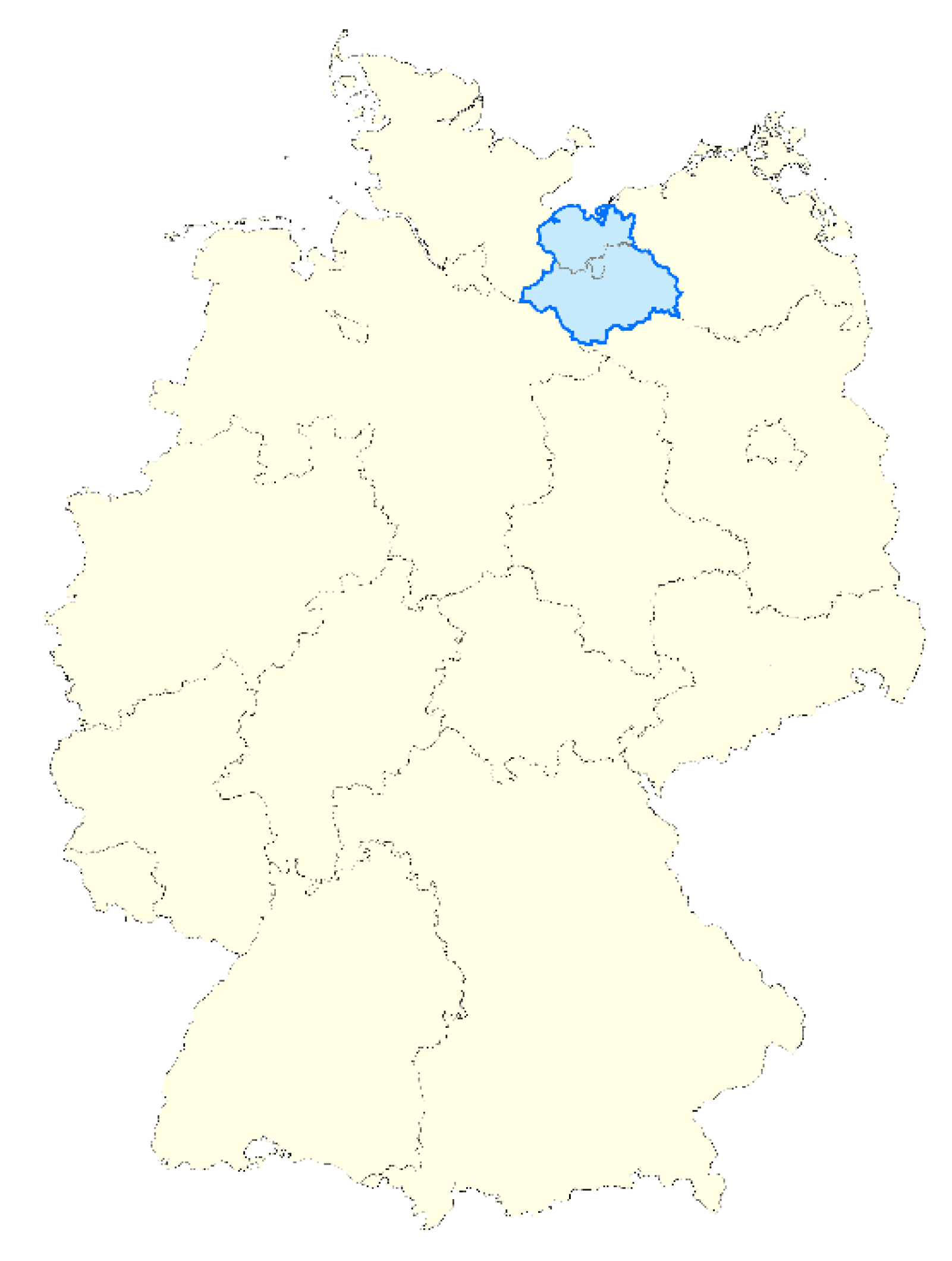The results showed that the presumed dichotomy between urban and rural areas is reflected in the empirical data only to a limited extent. On the one hand, urban-versus-rural was a frequent and important conflict line; thus, an urban–rural dichotomy was recognizable. On the other hand, however, the majority of conflicts did not involve an urban–rural conflict line; this finding emphasizes that the overall picture is more diverse than the urban-versus-rural narrative suggests. In the following sections, the results are presented in detail.
3.1. Urban–Rural Conflict
Urban–rural conflict does play a role in the study region, as urban-versus-fringe was the most common conflict line detected. In 48 of the 124 conflicts analyzed, actors who were predominantly affiliated with the city of Schwerin and actors who were predominantly affiliated with its fringe were on opposing sides. These conflicts most frequently centered on questions of settlement development, particularly in relation to how much construction of new housing was allowed in fringe communities (also see
Table 2). As the number of residents has much influence on communities’ revenue, and demand for housing in the fringe is high, developing new housing areas is the most promising way to generate higher revenue for many fringe communities. However, the city competes for residents with fringe communities, and the issue has become a delicate topic. In line with the often-cited urban-versus-rural narrative, communities in the fringe feel disadvantaged, as the city aims to restrict their development and is favored by German planning law. Furthermore, environmental/species conservation, infrastructures, and recreational/touristic land uses are prominent conflict issues between fringe and city actors. For example, ecological compensation areas, which are required by German planning law to compensate for the environmental impacts of new construction, are a frequent cause of dissent between the fringe and the city. The city of Schwerin lacks the space to provide compensation areas for its own construction projects within its limits and therefore depends on space in the fringe communities. However, as land used for ecological compensation areas is normally lost to other land uses, such as agriculture or construction, and thus decreases in economic value, fringe actors often perceive compensation areas as a burden. These conflicts also align well with the common narrative, as actors in the fringe do have to bear the negative consequences of development within the city.
In contrast, conflicts between the city of Schwerin and the rural areas outside the direct fringe were rare. This constellation was found in only two conflicts. One was about ecological compensation areas for construction within the city of Schwerin, similar to the conflicts over compensation areas described above. The other was about parking lots in the city that are used by commuters from both the fringe and communities outside the fringe. As space in the city center is scarce, there is competition between commuters and city dwellers for parking lots but also between parking lots and other land uses, such as for moving traffic. The low number of conflicts between the city and the rural areas outside the fringe might be influenced by the focus on the fringe during data collection; however, the contrast with the high number of city-fringe conflicts is still striking and supports the initial assumption of this study that spatial proximity increases the likelihood of conflicts.
Interestingly, more conflicts were detected between rural areas outside the direct fringe and cities other than Schwerin, even though other cities were not the focus of the interviews. This was the case for a total of five conflict lines. This may have been because most other towns in the region do not have an official fringe. In these cases, the analytical categories “rural areas outside the fringe” and “city” border each other directly, and this spatial proximity might have increased the number of conflicts.
3.2. Other Conflict Lines
Despite the relatively high number of city–fringe conflicts, the results of this analysis underline that urban–rural conflict is not the dominant element in land use conflicts in the study region. More than half of all conflicts did not involve an urban–rural conflict line. Instead, actors from the city of Schwerin, from its fringe, and from rural areas outside the fringe were frequently in conflict with actors with the same spatial affiliation; this finding further strengthens the idea that spatial proximity plays a role in land use conflicts. In 44 conflicts, a fringe-versus-fringe conflict line was detected; in 22 conflicts, a city-versus-city conflict line was detected; and in 10 conflicts, a conflict line within the rural areas outside the fringe was detected. After city-versus-fringe conflict lines, these were the next most common conflict lines.
Fringe-versus-fringe conflicts most frequently concerned the construction of infrastructures for traffic or renewable energy (see
Table 3). In addition to negative impacts on local residents due to noise or visual blight, infrastructure projects are controversial because they lead to a loss of agricultural land. This is particularly problematic because agricultural land is also under pressure from housing development and environmental conservation efforts (as described in
Section 3.1). Additionally, residents of the fringe repeatedly protested against nuisances caused by agricultural facilities, such as odor, pollution, and traffic. As Schwerin’s fringe is shaped by large-scale agriculture that is spatially intertwined with housing areas, this might come as little surprise. Farmers, in turn, felt that local residents had no appreciation for agriculture. Interestingly, these conflicts are in line with the urban–rural conflict narrative, which holds city dwellers accountable for nuisances and infrastructure development. However, this point was rarely raised in the interviews describing these conflicts. Instead, the conflict lines appeared between residents and local business owners, developers, or farmers, sometimes involving the administrations that regulate the issue in question or foreign investors, as described in more detail below.
City-versus-city conflicts most often concerned the development of traffic infrastructure within the city, with land users opposed to the loss of land and residents concerned about increased traffic volumes (also see
Table 4). For example, the construction of a bike lane along Schwerin’s lake shore caused residents to mobilize because they did not want to lose private access to the lake and were worried about noise nuisance. While conflicts about housing were much more frequent in the fringe, they were still the second-most important issue in the city. Here, construction of housing, among other issues, endangered a fresh air corridor, causing a conflict between the climate change management of the city and plans to provide more housing.
Conflicts within the rural areas outside the fringe were frequently shaped by land use competition between different sectors, such as housing, industry, agriculture, and tourism, and were relatively evenly distributed over the different land use types (see
Table 5). For example, a new industrial park in a rural community led to a series of conflicts because it increased traffic volumes and demand for housing and was located inside a biosphere reserve, threatening the region’s recreational value. Similar to the conflicts around agricultural land uses in the fringe, residents of the rural areas farther away from the city also complained about nuisances caused by agriculture, such as odor and flies. In addition, the loss of agricultural land due to the construction of infrastructure or housing, as well as compensation measures for construction projects in rural communities, appeared repeatedly in conflicts outside the fringe.
Furthermore, many other actor constellations appeared that involved actors from other regions or other administrative levels, such as the whole state of Mecklenburg-Western Pomerania or the Federal Republic of Germany. Actors from the city of Schwerin, its fringe, and adjacent rural areas outside the fringe were in conflict with actors from other regions or administrative levels on 23 occasions (see
Table 6 for an overview of the contested land uses in these conflicts). Most often, this involved land uses for infrastructures or environmental/species conservation. For example, local residents opposed to the construction of energy infrastructure often directed their protest at the federal government for its efforts to expand renewables. Investors from other states, or even foreign countries, were also repeatedly involved in these conflicts. Farmers, on the other hand, complained that the European Union’s Common Agricultural Policy’s incentives sometimes undermined environmental conservation efforts. For instance, according to some interviewees, environmentally valuable flowered areas have to be plowed every four years to maintain their status as arable land and for the farmers to continuously receive subsidies for them; this was a requirement that many farmers found illogical. In total, 22 different types of spatial conflict lines were identified, excluding conflict lines that involved an “unclear” party. Interestingly, actors from the fringe were by far the most frequently involved in conflict lines, being participants in 126 of the 178 individual conflict lines. For an overview of all the conflict lines, as well as their frequencies, see
Table A1 in the
Appendix A.
Finally, actors from the city of Schwerin and actors from its fringe also formed alliances. This was the case in 15 of the analyzed conflicts. For example, both the city of Schwerin and communities on its fringe would like to develop touristic infrastructure in the region, but they repeatedly come into conflict with environmental conservation interests. Thus, a passenger ship line that would have connected touristic sites in Schwerin with sites in a fringe community could not be established because of environmental concerns regarding the construction of a new dock. Such issues are common in the region because its high natural value attracts tourism but also carries environmental obligations. Moreover, another 15 conflicts involved actors or actor groups that were equally affiliated with the city of Schwerin and its fringe. For instance, a loose group of water sports enthusiasts from the whole region who are in favor of lenient rules for navigation is in conflict with conservationists, who are worried about the impacts of water sports on endangered species. Thus, in a total of 30 conflicts, actors from the city of Schwerin and actors from its fringe appeared on the same side, which further calls into question the idea of an urban–rural dichotomy in land use conflicts. For the complete results of the text analysis, with conflict lines and city-fringe alliances marked for each conflict, refer to
Table S1: Results of the text analysis in the
Supplementary Materials.
It is, however, important to note that, for a few conflicts, there was too little information available to identify the spatial affiliations of all the conflict parties. This was the case for ten conflict lines in which at least one actor whose spatial affiliation remained unclear was mentioned by the interviewees. Thus, some uncertainty remains, even though ten additional conflict lines do not negate the trends that were apparent in the other results.







